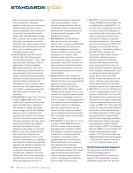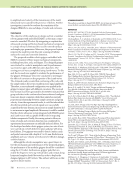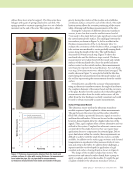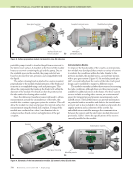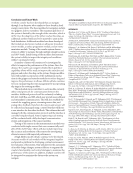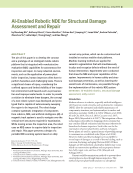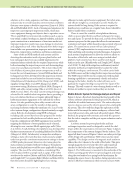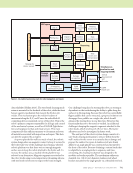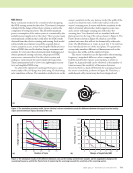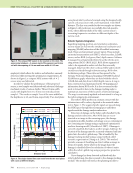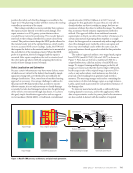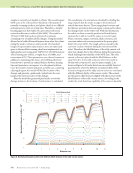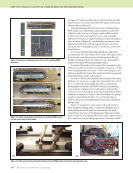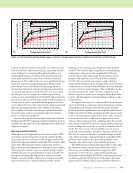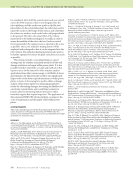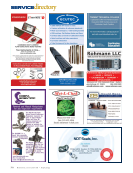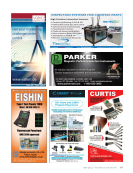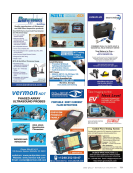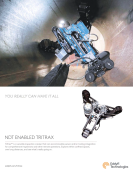734 M A T E R I A L S E V A L U A T I O N • J U L Y 2 0 2 1 peristaltic pump is used to transfer the gel from a reservoir to the tube’s inner surface. A chamber at the front of the module houses a reservoir containing the gel and the pump. Due to the available space in the module, the pump selected was based on its size, flow rate, pressure, and compatibility with the liquid. The surface-cleaning brush is attached to a motor mounted perpendicular to the module. Radial extension of the brush and its motor is accomplished using a rack and pinion gear. This allows the components that make up the brush to fit within the diameter of the module. The brush can then be positioned on the tube surface for cleaning when needed. Since the ultrasonic transducer sensor will need to obtain measurements around the circumference of the tube, this module also contains a spur gear system for rotation. This will allow the module to rotate and prepare the internal surface for measurements using the brush and couplant. Testing of the module was conducted in a clear 5 cm diameter tube to evaluate surface-brush contact and application of the gel couplant. Instrumentation Module To improve the functionality of the crawler, an instrumenta- tion module was developed that contains a variety of sensors to evaluate the conditions within the tube. Similar to the previous modules, this module uses a carousel-type motion with a spur gear system (Figure 9). Six modular panels spin 360° concentrically about the center of the tube. Each panel design can be modified to support a different sensor. The module currently includes three sensors for assessing the tube conditions, although there are three more panels available for additional sensors in the future. The three current sensors include an analog video camera, an environmental sensor for temperature and pressure measurements, and a LiDAR sensor. The LiDAR sensor can provide information on potential surface anomalies and defects. An inertial meas- urement unit is also included in the module and provides the angular position and acceleration of the crawler. An embedded microcontroller manages the communication between the sensors and the electronics module discussed previously. Table 1 shows the specifications of the sensors currently installed in the module. ME TECHNICAL PAPER w robotic inspection of small-diameter superheater pipes Spur gear housing Surface brush and linear actuator Miniature peristaltic pump Couplant reservoir area Stabilization system Figure 8. Surface preparation module: (a) isometric view (b) side view. (a) (b) Sensors Spur gear housing Modular panels Camera Stabilization system Figure 9. Schematic of the instrumentation module: (a) isometric view (b) side view. (a) (b)
J U L Y 2 0 2 1 • M A T E R I A L S E V A L U A T I O N 735 Testing The development of the crawler system started with creating general concepts and initial prototyping and proceeded with bench-scale testing and engineering-scale testing of the system. This section presents the bench-scale testing used to validate the concepts and testing of the system in a tube with multiple bends and straight sections. Bench-Scale Testing Robotic crawler: To evaluate the pull force capability of the crawler, pull-force tests were conducted on the gripper and extender modules. The grippers were found to be capable of pulling approximately 84.5 N of force and the extenders were found to generate 40 N of force. These values demonstrate that the forces obtained previously in this paper are reason- able approximations of the actual pull forces. The pull-force tests were conducted using a digital weight scale attached to the ends of the modules. The value for the gripper was found by finding the maximum pull force before the gripper pads began to slip along a steel 5 cm diameter tube. The pull force for the extender was found by clamping the module to a flat surface and allowing the linear actuator to pull the scale. After the initial system was assembled, bench-scale tests were conducted to evaluate the crawler’s ability to navigate through both straight and 180° elbow sections. The elbow testing was conducted in a custom-built 5 cm diameter tube with a 7 cm bend radius. Although the system was designed to navigate through bends with a 5 cm radius of curvature, the smallest bend radius found in a transparent acrylic pipe was 7 cm. With this experimental setup, the crawler was easily able to navigate through the bend. The average speed of the crawler in straight sections was found to be 50 cm/min. The speed was slightly slower when navigating through the bends. Ultrasonic transducer module: To demonstrate the functionality of the ultrasonic transducer module, tests were performed in a clear acrylic 5 cm diameter straight tube with a wall thickness of 1.6 mm. The ultrasonic transducer gauge was calibrated to measure the thickness of PVC by adjusting the velocity of sound to 2390 m/s. Since the module was not inte- grated with the crawler for the bench-scale testing, the stabi- lization mechanism was adapted to be used at both ends of the module. Wall thickness was measured at three different locations around the inner circumference of the tube. The circumferential rotation using the spur gear set allowed the module to obtain measurements at different loca- tions along the inner wall of the tube. As shown in Figure 10, TABLE 1 Sensor specifications Sensor Measurement Range Resolution Unit Environmental • Temperature –40 to 85 ±1.0 °C • Pressure 26 to 126 ±0.02 kPa Inertial measurement • Acceleration ±2 to ±16 ±0.004 g • Angular velocity ±125 to ±2000 ±10.0 °/s Camera • Surface imaging 640 × 480 VGA pixel LiDAR • Circumferential mapping 10 to 60 ±1.0 mm Figure 10. Measurements performed on the tube’s inner surface showing the rotation of the crawler.
ASNT grants non-exclusive, non-transferable license of this material to . All rights reserved. © ASNT 2025. To report unauthorized use, contact: customersupport@asnt.org



























































